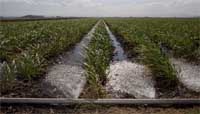
Growth for All with Sustainable Use of Resources
Today the main challenge in front of international community
is to sustain and accelerate the process of poverty eradication and ensure food
and energy security, particularly to developing countries while shifting
gradually to a Green Economy. A green economy approach to development holds the
potential to achieve greater convergence between economic and environmental
objectives. Agriculture plays a critical role in determining food, water,
ecological and livelihood security. Integrating the strategies and policies for
a green economy into agriculture has to proceed with an absolute imperative of
ensuring these and not forgetting the differentiated needs of subsistence
agriculture and market-oriented crops.
Also, transitioning to a greener model of agriculture will
depend on the expeditious provision of green technologies and financial support
to developing countries for productivity enhancement, improved resilience and
diversification of production systems.
Sustainable development and management of agriculture would
benefit from sharing of best practices including farm and non-farm development,
improved post-harvest management, integration of supply chains and strengthening
of public distribution systems. Eradicating poverty is an indispensible
requirement for sustainable development. A major cause aggravating poverty is
the unsustainable pattern of consumption and production. Poverty eradication
remains an overriding objective of governments in developing countries, and
efforts to build green economies should contribute substantially to realizing
that objective.
Integrating green economy strategies and policies into
poverty eradication, food security and energy security is an imperative for
sustainable development.Food security and access to affordable clean energy are
both crucial to eradicating poverty and promoting social development.The issue
of energy security and universal energy access is intricately linked with
economic development and growth, and rising energy needs to meet it.
Energy poverty coexists with inefficient energy use in much of the world, which
– given continued heavy dependence on fossil fuels – has been a major
contributor to greenhouse gas emissions. Understanding the flexibility or lack
of flexibility of each country to change this energy mix and devising innovative
methods to secure energy security are the need of the hour without compromising
on the need for high economic growth to meet the aspirations of the people,
especially in developing countries.
Energy security is a multi-faceted concept. In the current
context, the primary focus is on poor people’s securing adequate energy supplies
to raise their living standards, including through improved income generation,
health and education. Renewable energy should be considered as an integral part
of the solution to the energy needs of the poor, but that will only be feasible
if it is affordable and technologically accessible. As affordability is a
function in part of large-scale deployment and learning, the strategy to address
energy poverty needs to be linked to a broader alternative energy strategy as
part of a green economy.With respect to energy security, rural energy access
remains seriously deficient in many developing countries, with well over a
billion people lacking access to electricity and clean cooking and heating
fuels. At the same time, even in urban areas, electricity is often underprovided
and unreliable, especially for urban poor communities. This exacerbates poverty
and closes off escape routes by limiting income generation opportunities as well
as educational opportunities especially for girls.
What is Green Economy?
A green economy is typically understood as an economic system
that is compatible with the natural environment, is environmentally friendly, is
ecological, and for many groups, is also socially just. These attributes are the
conditions that must be imposed on an economy from the perspective of many green
economy advocates. This conventional concept of a green economy may be
alternatively described as “the greening of an economy”.
Some fundamental criteria for meeting these conditions have been established
since Rio, such as using renewable resources within their regenerative capacity,
making up for the loss of non-renewable resources by creating their renewable
substitutes, limiting pollution within the sink functions of nature, and
maintaining ecosystem stability and resilience. A Green Economy is a system of
economic activities related to the production, distribution and consumption of
goods and services that results in improved human well-being over the long term,
whilst not exposing future generations to significant environmental risks and
ecological scarcities. Conditions for social justice may include: 1) not
compromising future generations’ capability to meet their needs; 2) the rights
of poor countries and poor people to development and the obligations of rich
countries and rich people to changing their excessive consumption levels; 3)
equal treatment of women in access to resources and opportunities; and 4)
ensuring decent labor conditions. A green economy is one that results in
improved human well-being and social equity, while significantly reducing
environmental risks and ecological scarcities.